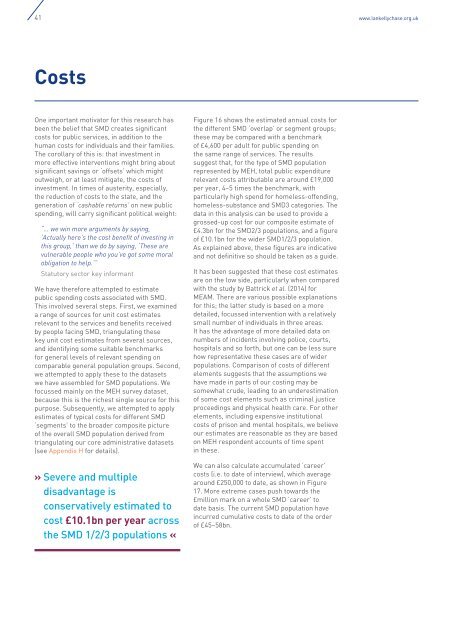Hard_Edges_Mapping_SMD_FINAL_VERSION_Web
Hard_Edges_Mapping_SMD_FINAL_VERSION_Web
Hard_Edges_Mapping_SMD_FINAL_VERSION_Web
You also want an ePaper? Increase the reach of your titles
YUMPU automatically turns print PDFs into web optimized ePapers that Google loves.
41<br />
www.lankellychase.org.uk<br />
Costs<br />
One important motivator for this research has<br />
been the belief that <strong>SMD</strong> creates significant<br />
costs for public services, in addition to the<br />
human costs for individuals and their families.<br />
The corollary of this is: that investment in<br />
more effective interventions might bring about<br />
significant savings or ‘offsets’ which might<br />
outweigh, or at least mitigate, the costs of<br />
investment. In times of austerity, especially,<br />
the reduction of costs to the state, and the<br />
generation of ‘cashable returns’ on new public<br />
spending, will carry significant political weight:<br />
“… we win more arguments by saying,<br />
‘Actually here’s the cost benefit of investing in<br />
this group,’ than we do by saying, ‘These are<br />
vulnerable people who you’ve got some moral<br />
obligation to help.’”<br />
Statutory sector key informant<br />
We have therefore attempted to estimate<br />
public spending costs associated with <strong>SMD</strong>.<br />
This involved several steps. First, we examined<br />
a range of sources for unit cost estimates<br />
relevant to the services and benefits received<br />
by people facing <strong>SMD</strong>, triangulating these<br />
key unit cost estimates from several sources,<br />
and identifying some suitable benchmarks<br />
for general levels of relevant spending on<br />
comparable general population groups. Second,<br />
we attempted to apply these to the datasets<br />
we have assembled for <strong>SMD</strong> populations. We<br />
focussed mainly on the MEH survey dataset,<br />
because this is the richest single source for this<br />
purpose. Subsequently, we attempted to apply<br />
estimates of typical costs for different <strong>SMD</strong><br />
‘segments’ to the broader composite picture<br />
of the overall <strong>SMD</strong> population derived from<br />
triangulating our core administrative datasets<br />
(see Appendix H for details).<br />
» Severe and multiple<br />
disadvantage is<br />
conservatively estimated to<br />
cost £10.1bn per year across<br />
the <strong>SMD</strong> 1/2/3 populations «<br />
Figure 16 shows the estimated annual costs for<br />
the different <strong>SMD</strong> ‘overlap’ or segment groups;<br />
these may be compared with a benchmark<br />
of £4,600 per adult for public spending on<br />
the same range of services. The results<br />
suggest that, for the type of <strong>SMD</strong> population<br />
represented by MEH, total public expenditure<br />
relevant costs attributable are around £19,000<br />
per year, 4–5 times the benchmark, with<br />
particularly high spend for homeless-offending,<br />
homeless-substance and <strong>SMD</strong>3 categories. The<br />
data in this analysis can be used to provide a<br />
grossed-up cost for our composite estimate of<br />
£4.3bn for the <strong>SMD</strong>2/3 populations, and a figure<br />
of £10.1bn for the wider <strong>SMD</strong>1/2/3 population.<br />
As explained above, these figures are indicative<br />
and not definitive so should be taken as a guide.<br />
It has been suggested that these cost estimates<br />
are on the low side, particularly when compared<br />
with the study by Battrick et al. (2014) for<br />
MEAM. There are various possible explanations<br />
for this; the latter study is based on a more<br />
detailed, focussed intervention with a relatively<br />
small number of individuals in three areas.<br />
It has the advantage of more detailed data on<br />
numbers of incidents involving police, courts,<br />
hospitals and so forth, but one can be less sure<br />
how representative these cases are of wider<br />
populations. Comparison of costs of different<br />
elements suggests that the assumptions we<br />
have made in parts of our costing may be<br />
somewhat crude, leading to an underestimation<br />
of some cost elements such as criminal justice<br />
proceedings and physical health care. For other<br />
elements, including expensive institutional<br />
costs of prison and mental hospitals, we believe<br />
our estimates are reasonable as they are based<br />
on MEH respondent accounts of time spent<br />
in these.<br />
We can also calculate accumulated ‘career’<br />
costs (i.e. to date of interview), which average<br />
around £250,000 to date, as shown in Figure<br />
17. More extreme cases push towards the<br />
£million mark on a whole <strong>SMD</strong> ‘career’ to<br />
date basis. The current <strong>SMD</strong> population have<br />
incurred cumulative costs to date of the order<br />
of £45–58bn.


